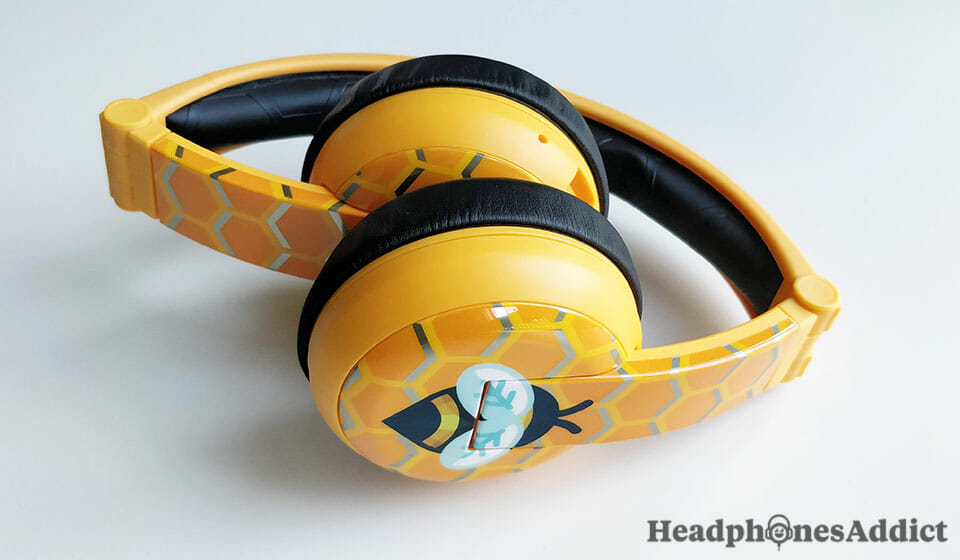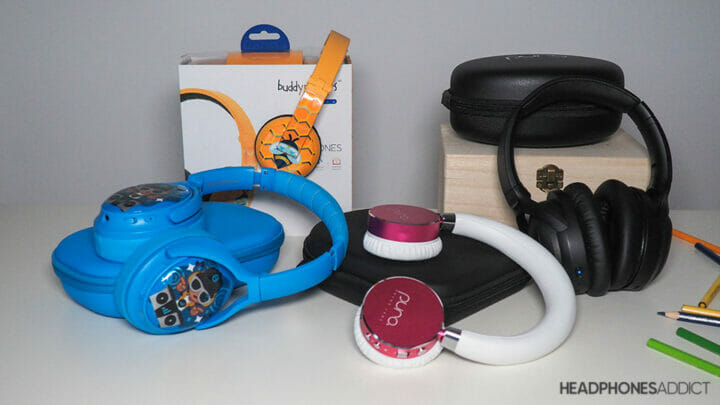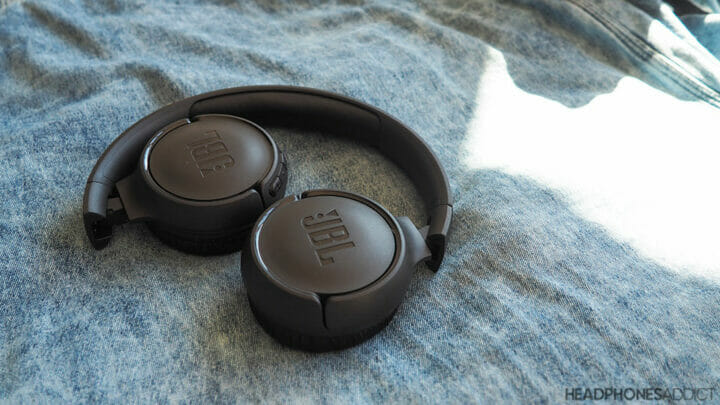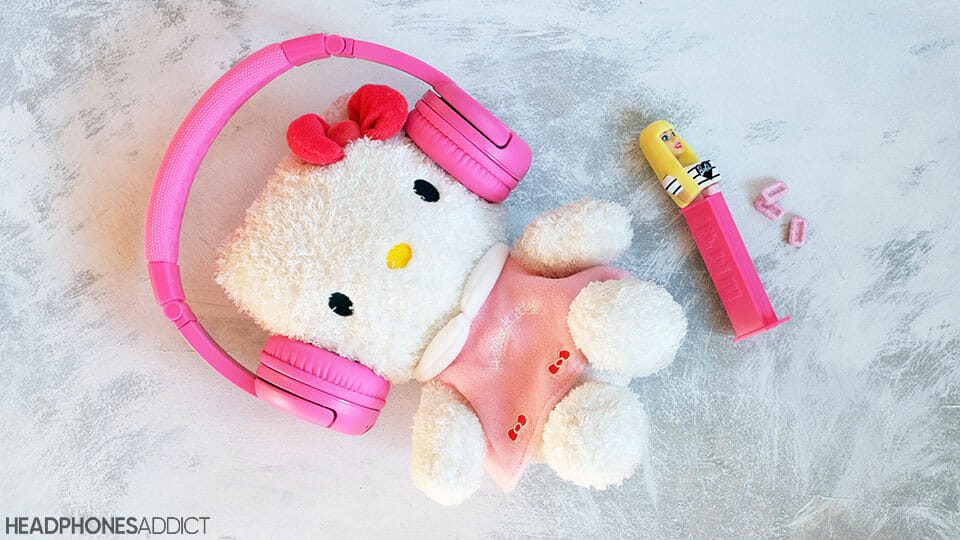
If you want feature-packed Bluetooth headphones for kids that don’t cost an arm and a leg, then BuddyPhones Play+ are your best option.
BuddyPhones Play+ are surprisingly well-rounded headphones for toddlers with 3 different volume limiters (75, 85, and 94dB) and a Study Mode, which essentially reduces bass to a minimum.
On top of that, headphones are wireless, sound good, and pack a good battery life. More on that later.
BuddyPhones Play+ can fold, come with their own carrying bag, decorative stickers, and an included audio cable to pair 2 headphones with one audio source (yes, you can share audio with others).
In contrast, since they’re affordable, the build quality isn’t impressive. They lack essential water resistance, which is useful for little kids.
However, the Bluetooth headphones for kids are hard to beat for the price (around $50). Keep reading to see what other goodies you get with the BuddyPhones Play+.
Or check other kids headphones.
- Great sound quality (for the price)
- 3 volume limiters
- Study mode for better concentration
- Good battery life
- Good comfort and stability
- Flexible design
- But a bit cheap-feeling
- Mediocre Bluetooth range
- No IP rating
Sound

Headphones pack a surprisingly lively sound with good bass slam. But switching to Study mode reduces the bass and clears up the vocal range.
Since BuddyPhones Play+ are budget headphones for kids, you’d expect basic sound quality, lacking in definition and clarity.
However, BuddyPhones Play+ are completely different. While they retain the bass boost of their predecessor (BuddyPhones Play headphones), they’re also fun to listen to.

Bass
Lower frequencies have a good extension (despite an on-ear fit) and pack a good punch. Headphones are definitely on a bassier side, adding nice warmness to the overall sound signature.
Kids will absolutely love how these headphones play.
On the other hand, enabling Study mode reduces the bass almost entirely. It helps kids focus on school work.
Midrange
In Music mode, the mids are relatively balanced and free of harshness and sibilance.
Switching to Study mode, headphones further boost the mids to amplify the vocal clarity. That way, your kid will more easily understand the teacher during online lessons.

Treble
For the most part, the treble is smooth and clear. However, it quickly rolls off, meaning instruments like cymbals don’t sound very loud.
Nevertheless, BuddyPhones Play+ are very enjoyable to listen to, even for an adult. The sound quality is excellent for the price.
Volume Limiters Performance
Long exposure to loud sounds can lead to permanent hearing loss. That’s why headphones for kids use volume-limiting to reduce max loudness.
However, not all volume-limiting headphones work as advertised. Consequently, we decided to test BuddyPhones Play+ in all possible modes to see if they’re as loud as the manufacturer says.
You can read more about the tests below.
White Noise Test (Music Mode)
| Loudness (Mode) | 75dB (Toddler) | 85dB (Kids) | 94dB (Travel) |
| Results | 79.9dB | 86.7dB | 96.2dB |
For the most part, BuddyPhones Play+ stay in the margin of error (+-3dB). However, they’re almost 5dB louder in Toddler mode.
Note that a 3dB increase in practice means double the loudness. While the difference isn’t that noticeable in the real world, a toddler’s ears are sensitive, and even smaller prolonged increases in volume can result in hearing loss later in life.
White Noise Test (Study Mode)
| Loudness (Mode) | 75dB (Toddler) | 85dB (Kids) | 94dB (Travel mode) |
| Results | 81.3dB | 88.4dB | 98.1dB |
Compared to the regular Music mode, enabling Study mode raises the maximum volume loudness by 2dB. That pushes all the modes away from the margin of error, especially the 75dB mode.
Music Test: The One That Matters
| Loudness (Mode) | 75dB (Toddler) | 85dB (Kids) | 94dB (Travel mode) |
| Results | 79.2dB | 86.4dB | 98.1dB |
The results are very similar to the white noise test, if not slightly better. However, that Toddler mode is still a bit too loud.
Still, on average, the loudness was close to the advertised dB. Only occasionally, it spiked over the target. Therefore, for the most part, headphones are playing in the safe zone.
Wired Test (with a smartphone)

In Wired mode, headphones apparently only limit their max volume to 85dB. At the highest point (towards the end of the song) I got 86dB, which is safely within tolerances.
Headphone Amplifier Test: It Blew Up…
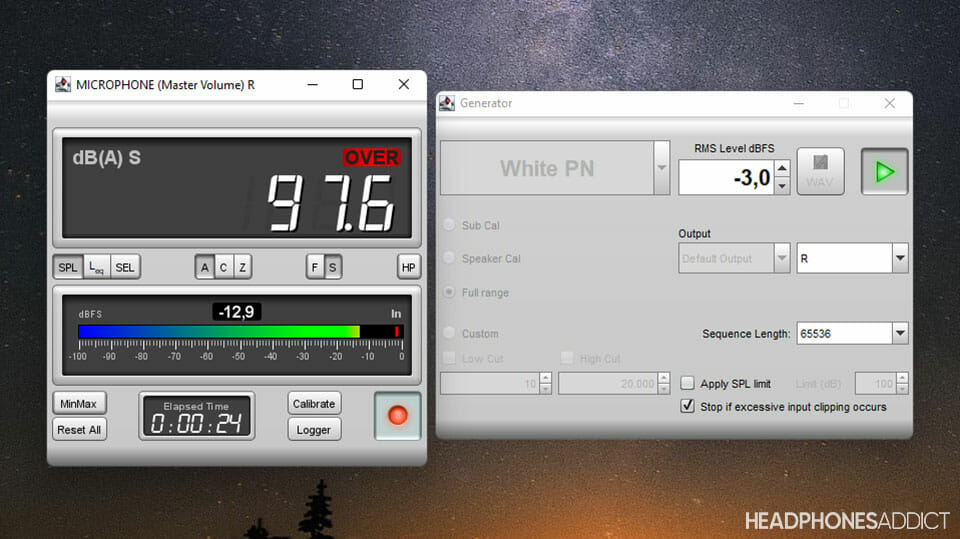
With headphone amp the headphones reached 97.6dB, which is higher than in Travel mode (98.1dB).
This is dangerous volume for kids. Though to be fair, a headphone amp will push most headphones way above the target loudness which isn’t possible with a regular cell phone or tablet.
So what’s the conclusion?
In real-world situations, BuddyPhones Play+ volume-limiter performs as advertised or close to the limit. While they can shortly spike above the target loudness, the volume stays under harmful levels most of the time.
Therefore, high volume isn’t a reason for concern. They’re safe headphones for kids.
How We Tested the Volume Limiter Accuracy?
We’re using loudness-calibrated MiniDSP H.E.A.R.S and REW software for recording and generating white noise (all frequencies playing at the same volume levels).
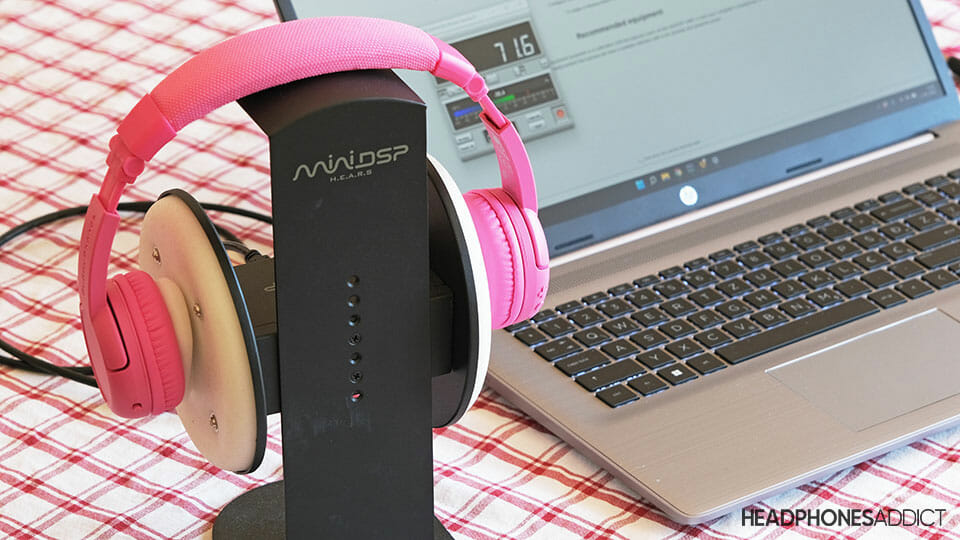
By playing at 100% volume, we test the accuracy of the loudness limiter inside headphones.
- For the majority of tests, we use a laptop (where we control more settings).
- For music tests we also use a smartphone. Either in Bluetooth or wired mode (with wired headphones for example).
- To test if you can drive headphones above their volume limit, we run them via a headphone amplifier (DragonFly Red).
Phones and laptops are the most commonly used gadgets among kids, so the results are relevant for real-life use cases.
For the conclusions and results, see sections above.
Comfort & Fit

Thanks to soft earpads with decent padding and a very lightweight design, your kids can wear BuddyPhones Play+ for a long time. They also hold onto the head quite securely.
On-ear design isn’t the best option for ensuring long-lasting comfort like the over-ear is. However, the comfort can get at least decent with good padding and soft materials.
That’s the case with BuddyPhones Play+. While they share many similarities with BuddyPhones Explore+, they use more comfortable earpads and gentler clamp force.
All that combined ensures sufficient comfort, even for older kids. Younger kids with little ears will easily wear these headphones during long car rides or lengthy remote learning sessions.

The Play+ can also provide a reasonably secure fit. Headphones sit on your head securely even with a little bit of shaking.
Kids should have no problem wearing them outside and jumping around without headphones falling off their heads.
Durability

Headphones are flexible and made of thick plastic, but they lack basic water protection.
The build quality is on par with the rest of the BuddyPhones lineup. Headphones are made of thick plastic, which feels cheap but should provide good protection against drops.

Protein leather earpads seem softer and of better quality than the Explore+ model. Also, they look replaceable, albeit it will be difficult to find the spare parts.
Headband extension is entirely plastic. However, it firmly holds the adjusted extension in place, even when vigorously shaking the headphones.
For extra portability, headphones fold inwards. The hinges are plastic but very tight, so the earcups can’t unfold on their own.

Additionally, you get a carrying pouch, which protects against scratches but not drops.
The included 3.5mm cable is flat and decent quality. However, it doesn’t straighten up (memory wire) and stays twisted.
Sadly, the most important thing is missing: water resistance (IP rating). Kids aren’t the most careful users, and spilling a liquid over the headphones is a matter of time.
Headphones aren’t even officially tested against sweat. Although, the latter shouldn’t be that big of a problem.
Battery

Headphones offer around 20 hours of playtime on moderate volumes and USB-C for charging. However, there’s no fast charging, at least officially.
BuddyPhones Play+ Battery Comparison

For such small headphones, you get reasonably long battery life. At normal listening volumes, you can expect around 20 hours of playtime (In our test: 19 hours and 48 minutes at 50% volume in 85dB mode).
The battery life also depends on the listening mode you’re on. Music mode is pumping more deep bass, which eats a bit more power.
USB type C port is a great addition so that you can use one cable to charge all your devices.
At least officially, BuddyPhones Play+ don’t support fast charging. Thankfully, they can still fully charge in about 2 hours.
Features

BuddyPhones Play+ are well-packed wireless headphones with 3 loudness modes, Music and Study mode, AUX port, decorative stickers, and essential physical controls.
At the great price of just $50, you get more than you expect. BuddyPhones Play+ are seriously feature-packed, with only lacking active noise cancellation (which isn’t necessary for kids).
First, there are three volume modes, making headphones safe for toddlers and much bigger kids as well. You switch between the modes by holding both volume buttons simultaneously.

You can toggle between Music and Study mode by switching a rather stiff physical knob on the left earcup.
Headphones also support essential playback controls, from play/pause, volume up/down, and skipping tracks.
If you ever end up with a dead battery, there’s an AUX port under the right earcup. The 3.5mm cable comes inside the box.
Moreover, by having other headphones connected to BuddyPhones Play+ via an audio cable, you can share the audio with friends headphones. Quite an awesome feature when two kids want to watch the same video or listen to the same music.

Last but not least, you get 4 pairs of decorative stickers to customize the headphones and a blank pair of stickers where kids can write their names on.
Microphone Quality
Sadly, the call quality is poor. Built-in microphone and its active noise cancelation (for calls) struggle to keep your voice clean even in a quiet room.
BuddyPhones Play+ microphone test
Nevertheless, headphones should work fine for speaking with a teacher or a schoolmate during online classes, despite a heavy background distortion.
Moving into a noisier environment, the quality drops, making your voice hard to pick up. Therefore, avoid noisy places for phone calls.
Noise Isolation

Headphones are pretty decent at passive noise isolation, blocking a noticeable amount of higher frequencies. However, they have no active noise cancellation.
Out of all budget BuddyPhones kids headphones, the Play+ do the best job at passive noise isolation.
They manage to block a noticeable amount of higher frequencies, whereas the lower end stays pretty much unchanged.
That is useful when you want to drown out the background noise from the passing cars. On the other hand, you will still hear engine noise on your commute.

It’s worth mentioning that since these are kids headphones, you don’t want to have the best noise isolation.
Worse isolation might hurt the audio quality, but it adds to surrounding awareness.
Therefore, BuddyPhones Play+ struck a nice balance between ensuring good sound and maintaining awareness.
Bluetooth

While the Bluetooth connection is pretty stable when the audio source is in the vicinity, the overall range is below average. There’s also a little audio delay and no multipoint support.
For the most part, the Bluetooth version 5.0 in BuddyPhones Play+ is doing a fine job of ensuring stutter-free performance. At least during regular use, that is.

The audio breaks quickly once you start moving away from your audio source. In my test, the audio becomes unlistenable even before passing a second brick wall.
That’s still around 35 feet, which is in line with the manufacturer’s claim. However, most headphones with Bluetooth connectivity can at least pass the second brick wall.
How to pair BuddyPhones Play+?
- Right out of the box, you simply turn them on, and they begin searching for a device to pair.
- Pairing them to another device later on, you first turn them off and then hold the power button until they turn back on, and you hear a “pairing” prompt.
Multipoint isn’t supported on BuddyPhones Play+. However, kids would hardly miss this feature.
What Bluetooth Codec Do They Use?
The Play+ only use a standard SBC Bluetooth codec. For the price, that’s more than enough, even though most wireless headphones also use an AAC.
Is There an Audio Lag?
Yes, but a tiny one when watching movies or YouTube videos. You can see a slight audio delay when looking directly into someone’s mouth. However, your brain will quickly adjust to the lag.
On the other hand, the delay might be more annoying if your kids play competitive mobile games. But then again, very young children shouldn’t play games too much.
Should You Get BuddyPhones Play+?

Compared to the School+ and the Explore+ models, adding only $20 to the price gives you a ton of extra features.
Bluetooth connection, good battery life, 3 loudness limiters, 2 listening modes, USB-C charging port, comfier earpads, and an AUX port to share audio with other headphones.

The only real drawback is the lack of sweat resistance and the overall plasticky construction. However, for $50, these are great headphones for kids that are hard to beat.
BuddyPhones Play+ is easily recommendable and deserves the spot in our best headphones for toddlers and kids guides.
Compare prices:
How do BuddyPhones Play+ compare to the competition?
- They offer a livelier, clearer sound that’s enjoyable for both kids and adults.
- Headphones offer longer battery life and a USB-C port.
- Apart from 3 volume limiters, they also have 3 EQ presets (Music & Study).
- They’re equally as plasticky and flexible as the competition.
- Some competitors offer an IP rating, whereas the Play+ don’t.
BuddyPhones Play+ Alternatives
BuddyPhones Wave
The Wave offer an IP67 rating, making them fully water-resistant. They’re also slightly better padded for higher comfort.
Headphones share similar decibel limits and slightly higher battery life (24h). While they’re more colorful, their looks aren’t as customizable.
On the flip side, the sound is rather lackluster in comparison.
BuddyPhones Explore+
A cheaper and wired alternative to the Play+ with a similar overall design. However, they don’t sound as good, nor do they provide the same amount of comfort.
Furthermore, they’re only limited to 85dB and lack additional listening modes. However, Explore+ provide a better call quality with their inline mic.
BuddyPhones School+
Another cheaper option but with an even blander sound quality mainly focused on vocal clarity.
These Onanoff Buddyphones headphones are meant for online learning, they come with a dedicated boom mic for significantly better call quality. However, they only offer an 85dB limit and have even smaller earpads.
What’s in the Box?

- BuddyPhones Play+ wireless headphones
- USB charging cable (type C)
- AUX cable with 3.5mm connection
- Carry bag
- 4 pairs of stickers + blank stickers
- User manual
Specifications
| Type: | On-ear |
| Connection: | Bluetooth 5.0 |
| Back design: | Closed-back |
| Drivers: | 40mm dynamic |
| Frequency range: | 20-20.000Hz |
| Impedance: | 32 Ohm |
| Weight: | 5.18oz (147g) |
| Mic & Controls: | Yes |
| Water resistance: | None |
| Battery life: | 20h |
| Charging time: | 2h – USB-C |
| Active noise cancelling: | No |
| Bluetooth codecs: | SBC |
| Wireless range: | 33ft (10m) |
| Microphone: | Built-in |

From a childhood fascination with sound, Peter’s passion has evolved into a relentless pursuit of the finest headphones. He’s an audio expert with over 5 years of experience in testing both audiophile and consumer-grade headphones. Quote: “After many years, I can confidently tell which headphones are good and which are terrible.” Find his honest opinion in his reviews.





